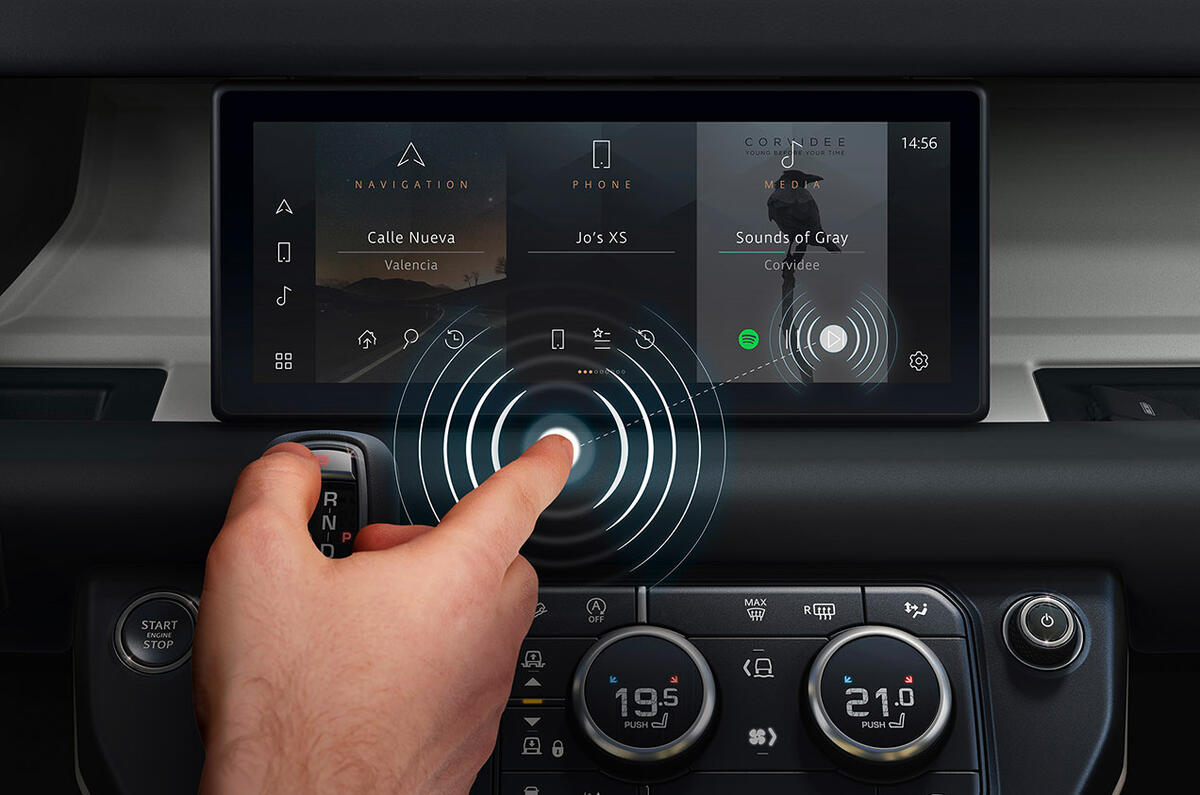Jaguar Land Rover has developed a new contactless touchscreen to reduce the transmission of bacteria and viruses, including Covid-19.
The patented ‘predictive touch’ technology was developed with engineers at the University of Cambridge and uses sensors to predict the user’s intended target on the touchscreen, so that they don’t have to actually touch buttons and risk transmitting viruses.
JLR claims the innovation, which is part of its Destination Zero project to improve vehicle cleanness and safety, also cuts drivers’ touchscreen use time by up to 50%, reducing the time drivers look away from the road and slashing the risk of accidents.
‘Predictive touch’ works by tracking users’ movements through vision-based or radio frequency-based sensors, using information such as the interface design and an eye-gaze tracker to infer which buttons they intend to press.
Unlike other gesture-based systems, such as the one found in current Volkswagen Group models, including the new Volkswagen Golf, this system goes further than simple left-right and up-down swipes.

JLR tech specialist Lee Skrypchuk said: “Predictive touch technology eliminates the need to touch an interactive display and could therefore reduce the risk of spreading bacteria or viruses on surfaces.
“The technology also offers us the chance to make vehicles safer by reducing the cognitive load on drivers and increasing the amount of time they can spend focused on the road ahead. This is a key part of our Destination Zero journey.”
University of Cambridge engineering professor Simon Godsill added: “Touchscreens and other interactive displays are something most people use multiple times per day, but they can be difficult to use while in motion, whether that’s driving a car or changing the music on your phone while you’re running. We also know that certain pathogens can be transmitted via surfaces, so this technology could help reduce the risk for that type of transmission.”
According to JLR, the technology can be easily incorporated into existing touchscreens, although there's currently no indication whether it will be added to either brand's production models.
READ MORE
Jaguar Land Rover reveals secret autonomous Project Vector
Jaguar Land Rover targets mobility market with car subscription scheme
Transport secretary: Covid-19 can drive green transport ‘revolution’




Join the debate
Add your comment
JLR should forget about this
JLR should forget about this and just invest in an office style system and combine that with what is now a fairly decent touchscreen. Just stop with the cleverness and refine what you have.
JLR should spend more money on Jaguars interiors and make them competive with Audi and Mercedes, forget BMW because they are worse than Jags.
Focus on what really matters. There's a lot of good stuff in JLR products but JLR need to make the last step and cross the Ts and Is to achieve that
Lol. Agree with all the above
On top of that, the already overburdened dealership network can't keep up with existing issues, never mind introducing potential new ones FFS.
I bet customers can't wait to keep flashing their eyes between your new non-touch touchscreen and the road to confirm if the iffy electronics have recognised where their finger was.
Do yourselves a big favour JLR, start spending some money on improving the quality of your interiors and reliability across the range, before it's too late.
No thanks, and maybe instead
No thanks, and maybe instead of employing tech for the sake of using it, car designers should look much harder at the ergonomics of where controls are located, so drivers don't have to look down and be distracted from driving a vehicle? what's wrong with making the controls more tactile, higher up on the dashboard or even employing some kind of heads-up digital display, on the lowest part of the actual screen? Buttons located along the top edge of the dash in a row, NOT obscured by the steering wheel and stalks? Is this too much to ask, or is this too great a 'styling' change?